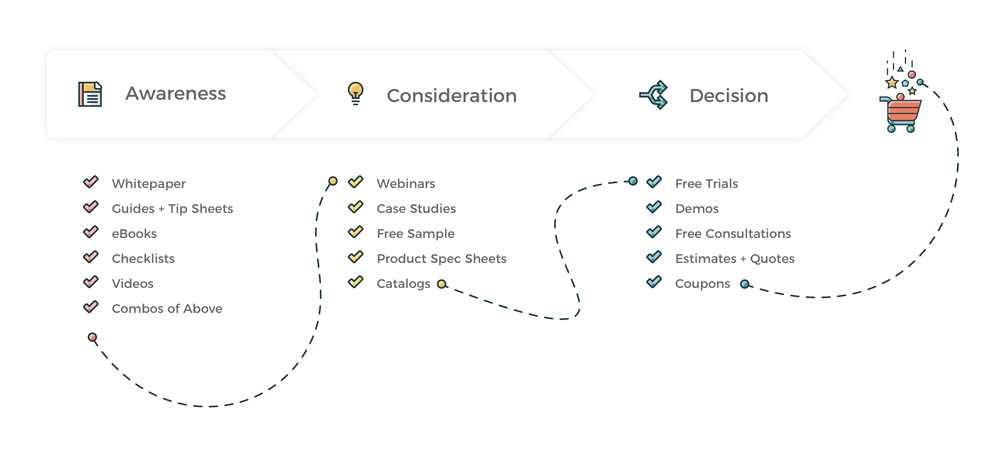
We often reference “the buyer journey” when planning new marketing campaigns and techniques with our clients. The buyer journey is a fundamental part of any inbound marketing campaign. We use it to make decisions about tactics and content that will help our target audience meet their needs.
But, what exactly is a buyer journey, and how does it fit into your bigger strategic planning?
In this article, you’ll learn the basics about the buyer journey, how to utilize it in a marketing campaign, and see examples from different industries.
Let’s get started.
What is a buyer journey, and why is it important?
Buyer journey definition
The buyer journey is a path your customer takes from the early stages of understanding his or her problem before ultimately making a decision to hire your company or purchase a product from your company. You can use the buyer journey as an analysis tool you can use to enhance your marketing to help customers work through solving their problems before making purchases.
When doing inbound marketing strategy planning, it helps to know which stage of the buyer journey your customers are in when you’re creating content and writing calls-to-action text.
When you customize your messaging to where your customers are in the buyer journey, you’ll help them down the sales funnel through your marketing efforts.
For example, if a lead is in an earlier stage of the buyer journey and you urge them to set-up a consultation too soon, you may turn them off and lose your opportunity to engage when they are ready. When you use the buyer journey as your reference, you’ll have no trouble turning leads into actual customers.
The buyer journey consists of three phases:
- Awareness
- Consideration
- Decision
Awareness phase
During the awareness phase, a person realizes he or she has a problem that needs to be addressed. This need might be related to health and wellness, career opportunities, transportation, financial planning, fashion, home improvement, food and drink, or something else altogether, and it usually results in someone buying a new item or paying for a new service.

Buyer journey example: the awareness phase
Jill, a mom of two, is frustrated because her oldest daughter’s brand new backpack is coming apart at the shoulder seam. The school year started less than a month ago, so a solution that only temporarily fixes the strap won’t do. Jill has a problem and needs to find a solution.
Consideration phase
After a buyer identifies his or her problem, his or her next step is to figure out the best options to resolve the issue. During the consideration phase, buyers evaluate the different ways available they can reach their goal.

Buyer journey example: the consideration phase
During the consideration phase of the buyer journey, Jill researches all of her options. Since she it’s too late to return the backpack to the store where she purchased it, Jill realizes that she needs to buy a new backpack for her daughter to use to carry her homework to and from school. She looks online at reviews for durable backpack options within her price range and asks her friends on Facebook for recommendations.
Decision phase
Once a buyer identifies the issue they are trying to solve and determines options to resolve it, he or she is in the decision phase of the buyer journey. At this point, the buyer’s goal is to make the right purchase with the right company.

Buyer journey example: the decision phase
Based on her online research findings and recommendations from friends, Jill narrows it down to two options. She ultimately decides to order a new backpack from a company that has good product reviews on their website and an offer for free shipping for first-time customers.
From the moment Jill realizes the backpack needs to be replaced to when she purchases a new backpack, she is taking part in the buyer journey. Now that you have a better idea of how the buyer journey works, we’ll explore how to optimize your marketing techniques to see better results.
How to use the buyer journey to shape your marketing strategy
At each stage of the buyer journey, your customer needs different types of information. You can use messaging, promotional strategies, and a variety of content to reach the right person at the right time.

Awareness phase marketing
The types of marketing messages that resonate with buyers in the awareness stage tend to be informational, educational, and non-pushy in terms of sales. The most effective content pieces don’t try to convince the user that your product is the best. Instead, these assets should be created to help your leads understand their problems more completely.
Consideration phase marketing
Once your leads have figured out their issue, they will start to research the best way to solve their problems. During the consideration stage, you should offer marketing pieces that help them to better understand all of the options available in the form of samples, detailed product information, and success stories from previous clients. While you can softly approach a purchase call-to-action in assets created for this phase, your leads still aren’t quite ready for a hard sell.
Decision phase marketing
When your leads get to the decision phase, they will likely be interested in offerings like free trials, demos, consultations, and other actions that immediately precede making purchases. Once they are ready to purchase, you don’t want to hamper their decision-making with more educational information. Those kinds of assets are better received when shared during the awareness phase. Instead, keep decision phase content short and sweet.
While the buyer journey can be applied broadly to most companies’ marketing planning, the specific buyer journey that your target audience will take is unique to your market, industry, and product(s)/service(s). You may even have multiple types of buyers (marketing personas) within your target audience and their buyer journeys may be slightly varied as well.
To get the most of your marketing campaigns and ensure success, spend time up front to consider your ideal buyers and their needs.
